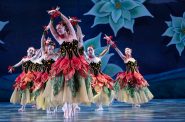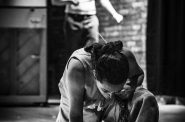Gullah culture, danced at UWM
Ferne Caulker, founder of Ko-Thi Dance Company, draws personal, artistic and academic connections to coastal Carolina African-American culture in the "Sweet Grass" show that opens Friday.
A picture of Ferne Caulker, at play on a beach in Sierra Leone as a little girl, hangs on a lobby wall over part of her late mother’s collection of ceramic figurines — salt shakers and such — that depict African Americans in stereotypical ways. A picture of her late father, looking sharp in a business suit, isn’t far away from a photo of Lorenzo Dow Turner, one of the earliest scholars of African-American history.
Over the last several years, Caulker and sometimes her students have made many trips to Hilton Head, Jekyll and other Sea Islands to interview Gullahs. They descend from slaves brought to clear fields, dig irrigation canals, build dikes and do the heavy lifting of the indigo, rice and cotton businesses. The islands also served as drop-off points in the slave trade.
Caulker, a long-time member of the dance faculty at UWM, views her Sweet Grass Project as a blend of dance, sociology, history and social action. Many Gullahs have been pushed off their land in the last several decades as resorts have taken over islands, most famously Hilton Head. Their story might help them make their case for preservation of their culture and their lands, and Caulker aims to disseminate that story. Post-Civil War, Gullahs traditionally made their livings by fishing, farming and basket-making, livelihoods threatened by development. The Sea Islands have seen controversy and legal and political action in recent decades.
In a walk through the theater space, now adorned with fishing nets and Spanish moss, Caulker spoke of Lorenzo Dow Turner (1890-1972), an African-American academic and linguist. Turner, known as the “Father of Gullah Studies,” took an interest in the Gullahs and especially in their distinct language, starting in 1929. He spent a good deal of time there, capturing local lore and song on bulky recording devices. He heard a kinship with West African languages, but couldn’t place them. Even the natives couldn’t translate some of their oldest songs, which predated their Gullah patois.
“Amelia Dawley sang what she believed to be a lullaby for Turner, but she didn’t know what the words meant,” Caulker said. “So he took this recording back to Chicago with him. And who is studying at the University of Chicago but Solomon Caulker, my father.”
Caulker came from an influential family in Sierra Leone. Turner asked him to translate, and Caulker had no problem with that. It was the language of the Mende people and well known to him. It turned out that the Gullah had appropriated a funeral dirge as a lullaby.
“When I was in the islands, I met Wilson Moran and Mary Moran,” Ferne Caulker said. “They are descendants and Amelia Dawley, who sang that song for Lorenzo Dow Turner. Now the link is complete.”
How to make a show of all this?
“It begins with ocean sounds,” she said. “That merges into a tumult of voices, from which, every now and then, an individual voice emerges.”
The dancers enter, each with streaks of indigo on their faces and bright swatches of African fabric on their slave costumes. A brief West African dance is a farewell to the old country; the African fabric comes off, and the dancers crowd together, in the way of slaves packed into the holds of slave ships.
UWM filmmaker Portia Cobb went to the islands and has contributed imagery to Caulker’s project. A ghostly ship is an homage to all those who did not survive the Middle Passage. Pictures of 300-year-old angel oaks native to the island are not only beautiful but bear the weight of history, as they bore human weight all too often — they were favored as lynching trees.
Caulker also borrows images from Nigerian artist Julien Sinzogan, of the Republic of Benin, West Africa. The dancers take up movement after his “Slave Yoke,” depicting human beings hitched up as oxen would be, a fact of life in slave days.
Caulker will appear in several guises, including the straw-masked egungun, a West African ancestral spirit who helps the people maintain their identity and strength amid physical and mental oppression.
Slavery led to flight, and one passage in the dance turns on the furtive, darting movement of escape. Flight through the Lowland marshes was terrifying, and not only because of the pursuit.
“The bugs, the snakes, the ‘gators, and then you hear those dogs,” Caulker said, demonstrating the way swatting of mosquitoes and shudders of fears can turn into dance movement. It’s not comfortable to do or watch, and neither is a passage in which all the dancers represent the choke and sway of a lynching. “This is what I want the audience to feel. I don’t want to abstract it.”
The mood changes as the dancers occupy the psychic space of the Praise House, the one place the masters allowed them a bit of sanctuary. A few vintage houses remain in the islands, and Cobb captured a one-room whitewash in a poignant image.
“The masters gave them that because they thought it was Christian,” Caulker said. “But the Gullah hid African messages and meanings in code in the songs. They were kind of like the Masons. Scholars are decoding them now.”
A bell ring, a funeral ends, and a joyous, defiant ring shout ends the show.
“Slaves were not allowed to dance — they couldn’t jump or cross their feet or play drums. But they could move in a circle — counterclockwise, as they do in Africa — and they could pound the floor with wooden staves,” Caulker said. “We’ll invite the audience to come down and join us in the circle. This is a heavy show, but it’s a celebration in the end.”
Concert Information: Showtimes are 7:30 p.m. Friday and 2 and 7:30 p.m. Saturday, May 17-18, in the Mitchell Hall Chamber Theater (Room 254) at the University of Wisconsin-Milwaukee.
Tickets: $12 adult/$10 UWM faculty & seniors/$9 UWM students/$5 PSOA students/Free to dance majors and children under 12. Order online or call the UWM Peck School of the Arts box office, 414 229-4308.
Dance
-
Milwaukee Ballet Brings Back Orchestra
 Jul 14th, 2025 by Bruce Murphy
Jul 14th, 2025 by Bruce Murphy
-
New Riverwest Company, Production Impresses
 Feb 10th, 2020 by Brendan Fox
Feb 10th, 2020 by Brendan Fox
-
Milwaukee Ballet Show Remakes History
 Feb 10th, 2020 by Catherine Jozwik
Feb 10th, 2020 by Catherine Jozwik
























